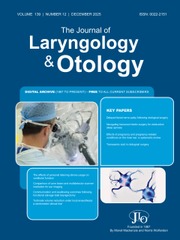No CrossRef data available.
Article contents
Association of vitamin-D deficiency with vestibular function in patients with idiopathic benign paroxysmal positional vertigo
Published online by Cambridge University Press: 21 October 2024
Abstract
This study aimed to investigate the impact of vitamin D deficiency on vestibular function and recurrence in patients with benign paroxysmal positional vertigo.
This study enrolled 138 patients diagnosed with benign paroxysmal positional vertigo. Vestibular function was evaluated, including ocular vestibular evoked myogenic potentials, cervical vestibular evoked myogenic potentials and caloric tests. Vitamin D levels were recorded.
There was a significant difference in mean vitamin D levels between the normal and abnormal groups of the caloric test, cervical vestibular evoked myogenic potentials, and ocular vestibular evoked myogenic potentials. The likelihood of abnormal vestibular function was lower in patients with normal vitamin D levels than those with deficient levels (< 10 ng/ml). Vitamin D levels were the only predictive factor for recurrence among patients with benign paroxysmal positional vertigo.
A deficiency in vitamin D is more likely to result in abnormalities in the caloric test, cervical vestibular evoked myogenic potentials, and ocular vestibular evoked myogenic potentials in benign paroxysmal positional vertigo patients. The interaction among these factors may contribute to the recurrence.
- Type
- Main Article
- Information
- Copyright
- Copyright © The Author(s), 2024. Published by Cambridge University Press on behalf of J.L.O. (1984) LIMITED
Footnotes
Ling Ding takes responsibility for the integrity of the content of the paper


